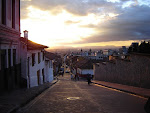This afternoon, three generations headed to the beauty salon: My grandmother, my mother and myself. The salon was creatively called “Hair and Care.” As my mother and I are undergoing dental surgery tomorrow, we decided to treat ourselves before the pain…
Because beauty and presentation is such an important aspect of Colombian culture (and Latin culture in general, I think), the beauty salon is an integral part of many Colombian women’s lives. Women of a certain social class make weekly and even biweekly trips to the salon for manicures, highlight touch-ups, and of course, cepillados. For those of you unfamiliar with Latin American beauty salons, let me paint the picture:
A couple manicurists--always women and usually in some kind of uniform resembling a nurse’s outfit--sit on a couple coaches reading magazines and waiting for customers. The hairdressers are sometimes women but usually men with frosted tips and tight black jeans. When you come in and sit down in the waiting area, you’re offered tinto or aromatica (herbal water), as well as an impressive selection of high society magazines. Salons tend to be smaller than in the U.S and there’s at least one salon per block.
Perhaps my favorite part is the salon owner. It’s almost always a woman who’s had excessive amounts of plastic surgery and, despite several probable liposuctions, wears clothing not particularly appropriate for her shape or age, such as pink leather pants, a tight purple top, leopard print high heels and huge hoop earrings. She embodies the “typical Latina” stereotype and walks around like the she’s the queen of England, but a little meaner. You can tell she’s the kind of woman you don’t want to get in a fight with, and even though she’s perfectly polite and pleasant to you, you feel a little sorry for the girls who work for her.
So now that I’ve set the scene, let’s talk about the different things that go on at the salon. Probably the most popular service is the cepillado. It’s particularly popular with older women, and consists of getting your hair brushed and blow-dried while reading a magazine and enjoying a coffee or aromatica. Those of you who’ve traveled to Latin America know the hairdo I’m talking about: The carefully blow-dried bob, dyed blonde and kept in place through lots of hairspray. It looks like a helmet was used to mold the hairstyle and almost every old lady you see is a fan. Typical price for el Cepillado: COL$6,000-COL$12,000.
Then there is the highlighting/hair-dying procedure. Until a certain age, women flaunt their long, shiny black hair with pride. But at some point, usually between the ages of 35-45, it seems most women decide that long hair is no longer age appropriate and the above mentioned bob is acquired. This change in hair length appears to trigger psychological changes that compel the client to dye her hair blonde, even if she’s naturally tanned, dark-eyed and Latin looking. Somehow, it just doesn’t seem right when someone’s hair is lighter than their skin; I don’t know if you’ve ever seen a person with naturally black hair try to go blonde, but the result is a strange, auburn, almost-glow-in-the-dark color. Because I’m American and walk around like a disheveled hobo (as my grandmother says), I’m not a big fan of the cepillado or highlights, though I don’t know if ten years down the road I too will succumb to the cepillado-bob.
But even though -- as of now -- I’m pretty happy with my dark, hobo hair, I’ve become fond of manicures and pedicures over the last few months. For COL$8,000 and COL$12,000, respectfully (at a decent salon), I can get my feet and hands done. For those of you not familiar with the Colombian peso, that’s about $10 for a manicure and pedicure. For three blissful hours, I sit in front of the manicurist and pedicurist, who files, exfoliates, massages and paints my nails. Getting your feet done, in particular, is blissful. So blissful you feel a bit guilty paying only $10.
But women aren’t the only ones who frequent the beauty salon; when a friend who will remain nameless came to visit last month, we went to get our hands done. It was his idea. Thinking it would be a quick, five minute procedure, he was shocked by the large container of products the manicurist brought to the table. He thought a man-manicure just meant the manicurist trimmed his nails. I think the poor manicurist felt like she was torturing him. The more tools she brought out – the file, the cuticle clippers, the oils, the creams – the more his look of confusion and dismay grew. Since I love seeing people suffer (only about insignificant things) I couldn’t stop laughing and provided no sympathetic support whatsoever. After the procedure was over and done with, he still wasn’t convinced. He hadn’t expected a 45-minute nail treatment. However, later that evening, after a few too many rum and cokes at the popular Zona T Irish pub, he confessed he loved the result and couldn’t recognize his own hands because they looked so good. He said he would be going back for regular manicures and brought up the amazing state of his hands at least ten more times that evening. I am sure he will love me telling this story, but it’s all just part of a Colombian sociological study. And you see all kinds of men come to the salon – businessmen, blue collar types with tattoos and motorcycles and old men and yuppies.
So three manicures and three pedicures later, my grandmother, mother and I leave the salon feeling like queens, are hands smooth and freshly painted, our feet rejuvenated and baby soft. These are the luxuries Colombia allows you. Well, at least until you start thinking about how little money the girls actually take home. Third world life can be complex and difficult to process when you’ve grown up in the developed world.
 I've discovered that earning a Colombian salary while paying American bills requires a bit more budgeting and planning than previously anticipated. To prove this point, I will disclose the contents of my pantry: Half a can of Milo, half a bag of rice, a (full) can of Antioquian beans, one egg, three sticks of Colombian hot chocolate, a bottle of soy sauce, a bottle of hot sauce, a packet of cumin, three cloves of garlic and a salt shaker. (Thankfully, my mother left me a 250-tablet bottle of vitamins to get me through this period of inadequate nutrition). Now I will disclose the contents of my wallet: COL $1,700 (Approximately US $0.85). I feel more Colombian already.
I've discovered that earning a Colombian salary while paying American bills requires a bit more budgeting and planning than previously anticipated. To prove this point, I will disclose the contents of my pantry: Half a can of Milo, half a bag of rice, a (full) can of Antioquian beans, one egg, three sticks of Colombian hot chocolate, a bottle of soy sauce, a bottle of hot sauce, a packet of cumin, three cloves of garlic and a salt shaker. (Thankfully, my mother left me a 250-tablet bottle of vitamins to get me through this period of inadequate nutrition). Now I will disclose the contents of my wallet: COL $1,700 (Approximately US $0.85). I feel more Colombian already.



















